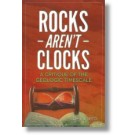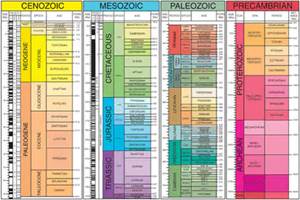To continue in our discussion of secular geohistory’s hidden fallacies, and a review of Dr. John K. Reed’s ‘Rock’s Aren’t Clocks-A Critique of the Geologic Timescale’, we’ve already covered secular geohistory’s hidden fallacies 1 & 2 in a previous post. Remember Dr. Reed’s admonition “If Christians are to understand Earth history, they must first understand how it was taken by secular thinkers.”
The four hidden fallacies are:
1) An ignoring of the worldview conflict between Christianity and Naturalism.
2) An assumption of the reality of ‘prehistory’ and its pre-human billions and millions of years.
3) An assumption that natural history is science, and not history.
4) Seeing more ‘history’ in the rocks than is really there.
So, let’s now turn to Fallacy #3: assuming natural history is just science. This fallacy stems from naturalism’s theory of knowledge (its epistemology) which makes science the final and ultimate arbiter of truth. Scientists are convinced that their investigations of the past are by definition scientific endeavors. You’ve heard the expression, the ‘facts of science’? This fallacy and expression assumes that when science speaks, it’s speaking true truth; that its truth claims can’t be challenged because they’re proven by science. But wait a minute, how can science study unique, unobserved, unrepeatable past events of history? The answer is that it can’t. No scientist was there to record the events of the deep past, so what naturalism does to get around this inconsistency is to proffer the concept of ‘uniformitarianism’.
Uniformitarianism is remembered by its famous though imprecise statement: “the present is the key to the past.”
According to Reed, ‘uniformitarianism’ works like this:
It works like this. If events in the past were similar to those we observe in the present, then scientists can study present day events and processes, and extrapolate back in time, confident that the sameness predicated by uniformitarianism will make their extrapolations valid.
So, if we change the rules of the game, and couch unique, unobserved, and unrepeatable past events in the scientific term of ‘uniformitarianism’, we’ve effectively moved the goalposts of what used to be the realm of history alone and moved it over to the realm of science. Do you see how easily this was done? And yet this is exactly what has happened. Uniformitarianism, as a scientific term and concept, then becomes unassailable. What a neat trick. The smart Christian should know better however.
You see mis hijas, “Christianity rests upon the Bible. The Bible in turn rests upon confidence in history in general and in revealed history in particular. The fatuous cliché, ‘the Bible is not a textbook of science,’ merely distracts from the fact that it is the only reliable textbook of ancient history'” (John K. Reed, Peter Klevberg, Chris Bennett, Jerry Akridge, Carl R. Froede, Jr., and Thomas Lott, Creation Research Society Quarterly, Vol. 41, No. 3 – Dec. 2004).
So in essence, what we now have is a natural history, purportedly resting on the supposedly scientific concept of uniformitarianism, against a natural history revealed by God Himself in the pages of Scripture. The two views are diametrically opposed to one another, and can’t co-exist in the mind of the Christian. The secularist believes his version of natural history, resting upon an unwarranted conclusion that ‘the present is key to the past’, and the Christian believes the word of God Himself as revealed in Scripture concerning God’s eyewitness testimony of the events of natural history. The problem is that many of your friends, beloved pastors, and theologians are today accommodating the secularist version of natural history. It is truly a travesty. They ought instead to be reminded of Romans 3:4 (NASB):
Rather, let God be found true, though every man be found a liar, as it is written,
‘THAT THOU MIGHTEST BE JUSTIFIED IN THY WORDS, AND MIGHTEST PREVAIL WHEN THOU ART JUDGED.’
With love, I remain,
Dear ol’ Dad
Vaya con Dios mis hijas




